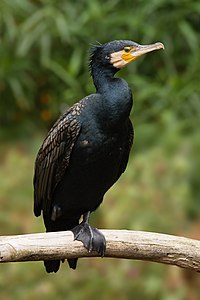
Photo from wikipedia
Abstract Harmonizing biodiversity conservation and natural resource management often requires anticipating the potential impact that certain species can cause through their exploitation of specific resources. During the winter 2008/2009 we… Click to show full abstract
Abstract Harmonizing biodiversity conservation and natural resource management often requires anticipating the potential impact that certain species can cause through their exploitation of specific resources. During the winter 2008/2009 we studied the feeding ecology of the Great Cormorant Phalacrocorax carbo sinensis in SE Spain, in order to determine its dependence on different food sources available along an oceanic-continental gradient (open sea-freshwater bodies). Trophic niche was assessed using C and N stable isotopes, applying up-to date metrics and analytical tools. Isotopic signatures revealed high mobility patterns for cormorants, illustrating differences between roosting and feeding areas (spatially well separated). Cormorants roosting in open sea move to inland freshwater bodies, their trophic niche overlapping that of individuals settled there. Similarly, individuals settled around transitional waters (coastal lagoon), seem to divide the predation pressure between different food sources along the marine-continental gradient. Recently in Spain, the Great Cormorant has been devoid of legal protection due to its supposed impact on fisheries. Our methods provide a useful and non-invasive tool that can be used as a first step for assessing such interaction. On the basis of its dispersed feeding distribution and expected predation pressure the cormorant does not seem to represent a serious threat to recreational or commercial fisheries which would justify downgrading its protection.
Journal Title: Estuarine, Coastal and Shelf Science
Year Published: 2019
Link to full text (if available)
Share on Social Media: Sign Up to like & get
recommendations!